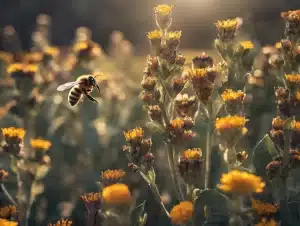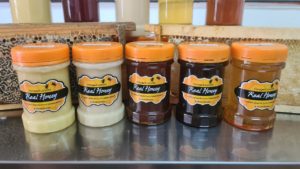I had a lot to learn But always beelieved I would succeed!
We had to generate money doing bee farming with this project…
Warrick, 2003
I started beekeeping while researching community projects for a local Rotary Club in District 9300 (Johannesburg) with funding from Rotary International, New Zealand and Department of Social Welfare.
The project involved 10 community members and about 26 hectares of land and was based on the old Rentokil Head Office in Olievenhoutbosch, Gauteng.
Zero bees.
Zero knowledge besides that bees make honey and they STING.
Bee Farming Community Start-Up, Thusanang 2003
After doing a bee farming course in Pretoria, I identified a complex industry that had multiple income channels and opportunities.
For me, getting income was the priority. I had a duty to the local community members to generate earnings.
My research showed bee removals created an immediate income generating opportunity. The community members did not have work. This project did not have wages. It had to be self funded. Training and bee equipment was funded but from then on it was up to us a team to make things work and make money... I had to make money too. I was not being paid for the project management nor for the research, work and all inputs. Plus, I had a family to provide for... and managing this project being away from home at night took me away from young kids and a wife... and carried running costs for petrol.
My research showed an opportunity in saving bees.
Warrick, 2003
I figured one of the best ways to make money and save bees was doing bee removals. I have 5 reasons for this to help our bee farming project.
- We got paid based on quotes we sent out over the phone or in emails
- We often could buy a catch box or brood chamber to safely contain the removed bees
- We charged enough to cover our fuel and expenses
- We had enough income to share profits
- and the bonus, was we could sell any honey we got
It took a long time in the beginning to figure out how much to charge. Days and weeks went by in the first spring and I took at least 5 calls a day.
People started referring people.
They somehow got my number from a school here and a fire station there.
It was lekker to be getting random calls from all sorts of leads. People and places I’d never contacted.
Every single day.
What was tough was figuring out what to actually charge. So many different calls for bees that were in different places, different locations and that would mean different difficulty.
Some bee removal jobs are easier than others. We figured over time that broadly customers would be less inclined to pay a fee if the job seemed easy like a collection on the ground floor where bees had not yet established. Meaning the bees had not yet established themselves.
No building of comb.
No real base that they were operating from.
No real time that has past since they arrived.
Customers would pay more for urgent jobs.
Customers would pay more for endangerment. Like when kids or pets were being put in harms way by the colony.
Customers would pay when the bees got overwhelming under the floorboards of bathrooms, air vents in old houses and water meters nearby drive-ways and and gardens.
Customers would pay a lot when chimneys and roofs had bees in them.
Any call outs that were above ground can be charged a higher rate.
As we explained the dangers and risks involved with these, like ropes and ladders and falls, customers began to recognise our commitment to working in difficult places and putting our health at risk.
We also started charging using a breakdown of costs.
Warrick, 2003
Customers liked when we quoted using a list of costs made up in the total. Once they understood there was a fee for petrol and our kilometers traveled, a fee for the container we would need to transfer the bees into, a fee fore ladders or ropes, a fee for our time and especially a fee for difficulty and risk factor.
It was a lot of trial and error. Customers didn't make it easy. We had a lot of opportunities to practice. During the spring, we got 5-10 calls a day. One night with a team of 3 we drove out to Harties to set up a out-trapping and, as it was after work, we had finished way after dark. We went as a team to all learn on the job. Driving back we were excited about getting another colony once the bees had moved into the out trap catch box - a method used to get bees to move out of a cavity and into a transition box that can take weeks - and were on the road home. Driving along the back road near Hartebeespoort dam we hit a thick foggy mist. I could not see further than a few meters from the headlights. It went on like this for minutes. I did slow down but not nearly as much as I should have. Talking about random topics to my team mates and driving while trying to make our journey home it was proving difficult. Surrounded by the mist I could just make out something dark that should not be there. Smack in the middle of the road. It was big. It was dark. Before I figured out what I was seeing I had almost hit it. If it was not ambling along with it's back to the car as if it had been asked to walk the solid line I would have hit it! A cow strode down the middle of the road! Almost hitting the cow we could've totally written off my car and likely ended up in hospital - if anyone even found out we were hurt in an accident. We were in the middle of Harties sticks! So, lesson learnt about making sure people had our pin location. And tracking on our phones.
One bee removal I took more than 60 stings…and a visit to Carstenhof Clinic
I had to take breaks at work to walk out and take these calls. Take about 5-10 minutes to quiz the customer.
Build a scenario in my mind of what the call out was being like, the costs and the time and then get an idea of the travel time and difficulty level all before being able to get photos sent easily.
Remember, this was 2003...
We always operated in teams. Teams of 2. Sometimes 3. But in the first few weeks we were the fantastic four! There was purpose. Only one of us had a driver's license. All of us needed to learn on the job. Discuss the job. Plan it. Do it. Share in the profits. Bring home the bees we saved. The rest of the beekeeping community member team took over.
The beekeeper team, they were designated, would look after the bee hives we saved - the bee farming.
Manage them and feed them.
Inspect them.
Split them and make more colonies.
We all harvested the honey.
Bottled it and sold it.
But some of the honey we got from the bee removals sold in the comb.
It made us money too.
The bees were saved we kept to farm with.
It was a triple income stream...
We made money charging to remove bees safely.
We made money selling the honey from the bee removal.
We made money keeping the bees to make more honey.
Then we discovered another income...
We started bee farming by saving bees and doing bee removals
As we grew our project apiary, we knew our space was limited.
The 26 hectares only had enough forage or flowers providing foods for about 20 hives to be kept sustainably.
We now had a new problem.
The first problem was Not having Bees…
This new problem. It was having too many…
After making money on the call out. Buying more catch boxes and brood chamber to transfer them into. Keeping 20 – 30 new bee colonies at the original project site and bee farming with them began to get too crowded.
We needed another site. We need more forage to make honey. We developed a two-pronged plan.
I would find new places to keep colonies we safely removed as call out jobs and bee removals.
I spoke with people that had had bee removals already done and called them back to ask if they wanted to keep bees on their land by giving their permission for us to manage them in proper bee boxes and do bee farming with them.
I had two options.
1) We would share 2-3 kilograms of honey harvested when we had enough.
We bought the hives. We supplied everything. We managed the colonies in a controlled bee hive.
This meant wild trekking colonies were less likely to return again to the same spot.
It kept customers happy from having to have another bee removal call out fee. And it gave us a secure site to keep our bees. Usually these sites were within urban areas with populated gardens providing quality forage for bees to collect nectar.
2) We offered a hive sponsorship model
Customers bought the hives
They would own the bee boxes and we would manage the bees
We split the honey harvest when it came time to take the honey from the colony.
Many times these customers became friends and became beekeepers over time.
It was truly ambassadorial work. A mission in the name of nature!
The new income model I discovered was selling bees we didn’t have homes for.
For the bees we could not keep. The bees we did not have sponsors for. The bees we just had no space for.
We found new beekeepers that wanted them.
Once we kept the wild or safely removed bees for a short while running through our check list we could sell them on to big beekeepers that needed to replace any lost colonies for pollination and new beekeepers that did not know where or how to start getting bees.
Now new beekeepers paid us for bees.
Big beekeepers paid us for bees.
The sales income was reinvested or paid out to members depending on what we needed for the project at the time.
The project developed and some members left to take full time jobs. I had uncovered a huge secret model to grow a business.
I stepped down from project manager with four of the members continuing the project and 1 getting their driver’s license – all funded by our income from the bee project and bee removals.
I began working on my new part time business in bee farming…
My bee business in a box was born!
2004

If you want to learn about bee farming we’ve got a variety of bee farming courses:
We also provide a bee removal directory service for students to get leads and referrals.
We get tons of calls during August – March – EVERY SINGLE YEAR!
Getting on www.beekeepinghub.com is included in the Commercial Bee Removal Course fee for 12-months!






